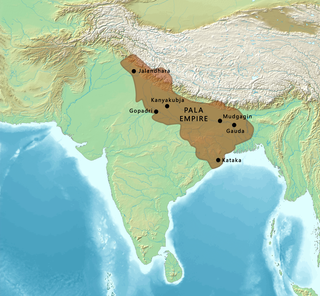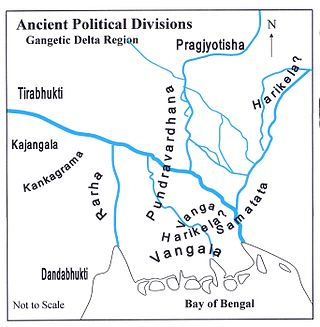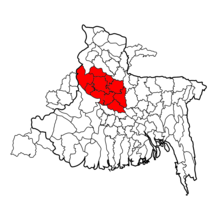
The Pāla Empire was an imperial power during the post-classical period in the Indian subcontinent, which originated in the region of Bengal. It is named after its ruling dynasty, whose rulers bore names ending with the suffix Pāla. The empire was founded with the election of Gopāla as the emperor of Gauda in late eighth century CE. The Pala stronghold was located in Bengal and eastern Bihar, which included the major cities of Gauḍa, Vikramapura, Pāṭaliputra, Monghyr, Somapura, Ramavati (Varendra), Tāmralipta and Jaggadala.

The Sena dynasty was a Hindu dynasty during the early medieval period on the Indian subcontinent, that ruled from Bengal through the 11th and 12th centuries. The empire at its peak covered much of the north-eastern region of the Indian subcontinent. The rulers of the Sena Dynasty traced their origin to the south Indian region of Karnataka.
Samanta was a title and position used in the history of the Indian subcontinent between 4th and 12th century to denote a vassal, feudal lord or tributary chief. The leader of 100 village also popularly known as jagirdar. The term roughly translates to neighbor. The institution is considered to be closely associated with the origin and growth of feudalism in India and Medieval India.

The Kamboja-Pala dynasty ruled parts of Bengal in the 10th to 11th centuries CE, after invading the Palas during the reign of Gopala II. The last Kamboja ruler of the Kamboja-Pala Dynasty Dharmapala was defeated by the south Indian Emperor Rajendra Chola I of the Chola dynasty in the 11th century.
Gopala was the founder of the Pala dynasty, which was based in the Bengal region of the Indian subcontinent. The last morpheme of his name Pala means "protector" and was used as an ending for the names of all the Pala monarchs. Pala does not suggest or indicate any ethnic or caste considerations of the Pala dynasty. He came to power in later half of eighth century AD in Gaur/Gaud after being elected by a group of regional chieftains.
Mahishya is a Bengali Hindu traditionally agrarian caste, and formed the largest caste in undivided Bengal. Mahisyas were, and still are, extremely diverse caste consisting of all possible classes in terms of material conditions and ranks.
The Ramacharitam is a Sanskrit epic poem written in Arya metre by a Bengali poet named Sandhyakar Nandi during Pala Empire. This work simultaneously narrates the story of the Ramayana and the Pala king Ramapala.It is mainly famous for describing the Varendra rebellion- a very critical event in early mediaeval history of Bengal.

Somapura Mahavihara or Paharpur Buddhist Vihara in Paharpur, Badalgachhi, Naogaon, Bangladesh is among the best known Buddhist viharas or monasteries in the Indian Subcontinent and is one of the most important archaeological sites in the country. It was designated as a UNESCO World Heritage Site in 1985. It is one of the most famous examples of architecture in pre-Islamic Bangladesh. It dates from a period to the nearby Halud Vihara and to the Sitakot Vihara in Nawabganj Upazila of Dinajpur District.

Gopala II was the successor to the Pala king Shurapala I in the Bengal-Bihar region of the Indian subcontinent, and the sixth ruler of the Pala line reigning for at least four years. The existence of this king came to light when, in 1995, historian Gouriswar Bhattacharya discovered two copper plate inscriptions of a previously unknown Pala king in Los Angeles County Museum of Art, where these had been sent for cleaning by a private collector. This king got designated as Gopala II; consequently, existing Gopala II and Gopala III were re-designated as Gopala III and Gopala IV, respectively. The text of these two inscriptions were subsequently edited by Ryosuke Furui in 2009.
Vigrahapala III was the successor to the Pala king Nayapala in the Bengal region of the Indian subcontinent, and twelfth ruler of the Pala line reigning for 15 years. He was succeeded by Mahipala II.
Mahipala II was the successor to the Pala king Vigrahapala III in the Bengal region of the Indian subcontinent, and thirteenth ruler of the Pala line reigning for six years. He was succeeded by Shurapala II.
Shurapala II was a ruler of the Pala Empire in the Eastern regions of the Indian subcontinent. He was the successor to the Pala king Mahipala II and fourteenth ruler of the Pala line, reigning for at least two years.
Ramapala was the successor to the Pala king Shurapala II in the Bengal region of the Indian subcontinent, and fifteenth ruler of the Pala line.
Madanapala was the successor to the Pala king Gopala IV in the Bengal region of the Indian subcontinent, and eighteenth and final ruler of Pala lineage reigning for 18 years. He was succeeded by Govindapala, whose lineage of that name is questionable.
Dineshchandra Sircar (1907–1985), also known as D. C. Sircar or D. C. Sarkar, was an epigraphist, historian, numismatist and folklorist, known particularly in India and Bangladesh for his work deciphering inscriptions. He was the Chief Epigraphist of the Archaeological Survey of India (1949–1962), Carmichael Professor of Ancient Indian History and Culture at the University of Calcutta (1962–1972) and the General President of the Indian History Congress. In 1972, Sircar was awarded the Sir William Jones Memorial Plaque.
Vijaya Sena, also known as Vijay Sen in vernacular literature, was the son of Hemanta Sena, and succeeded him as a Sena dynasty ruler of Bengal region of the Indian subcontinent. This dynasty ruled for more than 200 years. He conquered Bengal, fighting the kings of Gauda, Kamarupa, and Kalinga. He had a capital in Vijayapuri and Vikramapura.

Dibar Dighi is a tank in Bangladesh. An octagonal granite pillar, associated with Kaivarta chief Dibya, who usurped the Pala throne, stands in the centre of the tank.
Suvarna Banik, also called Bene, is a Bengali mercantile caste dealing in gold and silver. During the late 18th century, merchants of the caste became prominent in trade. In spite of their inferior ritual rank, they were the most well known trading caste in Bengal region as per the 1951 Census of India.

Mahipala was a notable king of the Pala dynasty, which ruled over much of the eastern regions of the Indian subcontinent between the 8th and 12th centuries. He was the son and successor of Vigrahapala II. Mahipala's reign marked a resurgence in fortunes for the Pala empire, whose boundaries were expanded as far as Varanasi. However, his rule was temporarily hampered by the northern expedition of the Chola Emperor, Rajendra I.

The Varman Dynasty was a Hindu Yadava dynasty of Indian subcontinent which ruled Bengal, and later East Bihar (Anga). The Varmans established their supremacy after replacing the Chandra Dynasty. Their capital was at Bikrampur in present-day Munshiganj District of Bangladesh.











